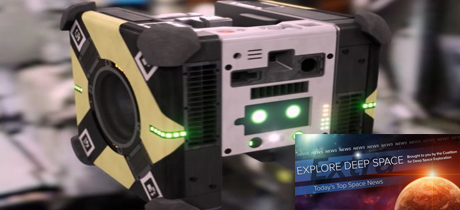In Today’s Deep Space Extra… NASA moves to acquire vital launch and spacecraft components for Artemis 3, an accelerated effort to return human explorers to the surface of the Moon in 2024. NASA, Mars scientists mark a productive seven years on Mars for the Curiosity rover. Small satellite launch ride share market showing rising economic promise.
Human Space Exploration
NASA starts buying long lead parts for third Orion ESM, SLS Core Stage
NASAspaceflight.com (8/5): Those long leads would be for a third test flight of NASA’s Space Launch System (SLS) and Orion capsule. The third test flight, designated Artemis 3, is to launch in 2024 and return U.S. human explorers to the surface of the Moon for the first time since the final Apollo mission, Apollo 17 in December 1972. The needed long lead components include the European Space Agency’s (ESA) Orion service module. Currently, only contracts for long lead items for Artemis 1 and 2 hardware are in place.
Tiny robot ‘bumbles’ through the air aboard Space Station
Space.com (8/5): In all, three Astrobees have taken flight within the International Space Station (ISS). These free flyers were designed to assist the astronauts with their maintenance chores, even look for lost items. Bumble and Honey were recently joined by Queen Bee.
Space Science
A crashed Israeli lunar lander spilled tardigrades on the Moon
Wired.com (8/5): A failed early April attempt by Space IL, of Israel, to soft land its Beresheet lander on the Moon at the Sea of Serenity sent a wave of concern as far as Los Angeles. There, the Arch Mission Foundation, was eagerly awaiting the outcome of the descent of the lander with its payload, a lunar library with digitized data, human DNA samples and thousands of tardigrades, or microscopic “water bears” known for their ability to survive harsh environments. After an analysis of the descent, the foundation believes the library is likely intact.
Curiosity rover celebrates seven years since thrilling Mars touchdown
Space.com (8/5): Monday marked the seventh anniversary of the dramatic Curiosity/Mars Science Laboratory rover landing at Gale Crater on Mars. Since its “sky crane” touchdown, the nuclear powered rover has been on the search for evidence of past habitable environments as it scales Mount Sharp, which rises from the nearly 100 mile wide crater. At seven, Curiosity has far outlived its two year primary mission.
New finds for Mars rover, seven years after landing
NASA/Jet Propulsion Laboratory (8/5): Since its August 2012 landing at Gale Crater, an ancient lake bed, on Mars, NASA’s Curiosity rover has traveled 13 miles to drill into rocks and study clay sediments to unlock the mysteries of changes to a Martian environment that was once more habitable.
Other News
Op-ed | Why Congress must enact commercial remote sensing reforms
SpaceNews.com (8/1): In an op-ed, U.S. Rep. Brian Babin, ranking member of the U.S. House Space and Aeronautics Subcommittee, calls on Congress to streamline the regulation of satellite remote sensing activities, a benefit to business, science and the environment.
Good news, bad news for Spaceflight: Satellite rideshare market is heating up
GeekWire.com (8/5): Major launch services companies are finding a valuable market in the launch of small satellites, or ride shares, equipped to accompany larger satellite prime payloads or to join large numbers of other small satellites as the single prime payload on a large rocket. The trend was a topic of discussion at the Conference on Small Satellites underway this week at Utah State University.
Northrop Grumman dives into Chesapeake Bay oyster reef monitoring
Coalition Member in the News – Northrop Grumman
WTOP of Washington (8/5): Virginia based Northrop Grumman has joined with the Chesapeake Bay Foundation and the Chesapeake Oyster Alliance to re-populate the bay’s oyster population, which is now estimated at close to 300 million, down from 600 million two decades ago. Northrop Grumman is working to bring new biochemical, acoustic sensors to help the effort by monitoring the underwater oyster habitat.

